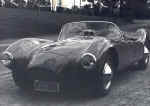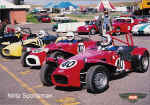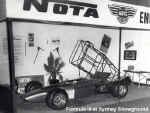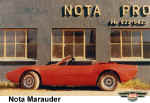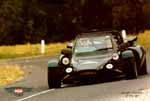By 1958, Nota was building all-enveloping aluminium streamlined sports cars called "Streamliners", later referred to as Mazengarbs. Nota made 11 of these cars up to 1960. In the latter part of the 50s, Nota started building mono posto racing cars, introducing Formula Junior racing to Australia. By 1960, Nota was also building specialist sports and single seater racing cars for hill climbing with people such as Barry Garner winning the NSW hill climb championship in the Nota Major - one of many championship wins by Nota cars. 1961 saw Nota making Australia's first mid-engined Formula Junior.
In 1963 Nota introduced a mid-engined Mini powered sports car, the first in Australia and possibly the world, which probably instigated the Fang of later years. In 1964, Nota started building its first purpose built road car, the Nota Sapphire, with a range of engines including the Coventry Climax racing engine; this car being offered with both coupe and open body styling.
1965 was the beginning of the Australian Formula Vee movement with Nota making the first Australian Vees for AARC at Warwick Farm race course. Nota went on to make 38 of the Vees, a mid-engined VW powered mono posto racing car, with people such as Peter Findlay winning the Formula Vee championship in them.
During the 60s, Nota introduced the "Sportsman", a clubman style sports and racing car which Nota still builds today with nearly 100 of these cars being built. Nota cars won 7 Clubman Championships, the most successful clubman type car in Australian history.
1968 saw the introduction of the Nota CP3 Chimera coupe. This car used an aluminium monocoque with suspension very similar to the Nota Formula III and Formula Ford, which Nota introduced at the same time; the Formula III being Australia's first.
In 1968 the Nota released the Fang and, although not as technically advanced as the CP3, it had outstanding performance per dollar with a better power to weight ratio than a Phase III GTHO Falcon of that time. This car was Nota's largest run of road cars with over 100 being made; probably Chris Buckingham's most successful design yet, with one now residing at Sydney's Power House Museum, its new owner.
By 1973 Nota had started on the Marauder range of cars, the first having the same mechanicals as the Nota Fang's mid-engined unit. In 1974 the Nota Levanti front engine twin cam was released. 1975 saw the Fang running out of Leyland 1275 GT engines, so Fiat was approached and a range of Marauders and Fangs were designed with the 2-litre twin cam Fiat/Lancia engine.
By the late 70's, Nota had started on the 4 wheel drive 351 V8 mid-engined Marauders and several of these were made when Ford decided to stop the 351s coming into the country. This situation brought Nota into the 80s when Chris Buckingham went to England and Europe to work in the racing car industry and bring back further new concepts for road and racing cars. On returning, Chris set up the design team from aircraft, car and bike racing personnel to implement the Nota (Fang) Fl 3 litre V6 quad cam sports car and is developing the fully enclosed, similarly specified Chimera.
A new car, the Le Mans, has been developed for the 2003 CAMS 2C Super sport category with either a Suzuki GTi 1300cc or 1100cc motor cycle engine (CAMS plans a future engine size increase to 1600cc, such as 4AGe Toyota ). For road use we can also offer the Toyota 1800cc VVTi 6-speed or the 3-litre V6 quad cam engine/gearbox.
Nota still provides its traditional Clubman style front engined cars, the Nota Sportsman, as well as specially built sports and racing machinery for those who require such.
If you would like to know more, there is a five-page article "50 Years of Nota" by Patrick Quin in the February 2002 edition of Australian Classic Car magazine. Click here to read what he said.
See also what the press says about Nota and its products.



